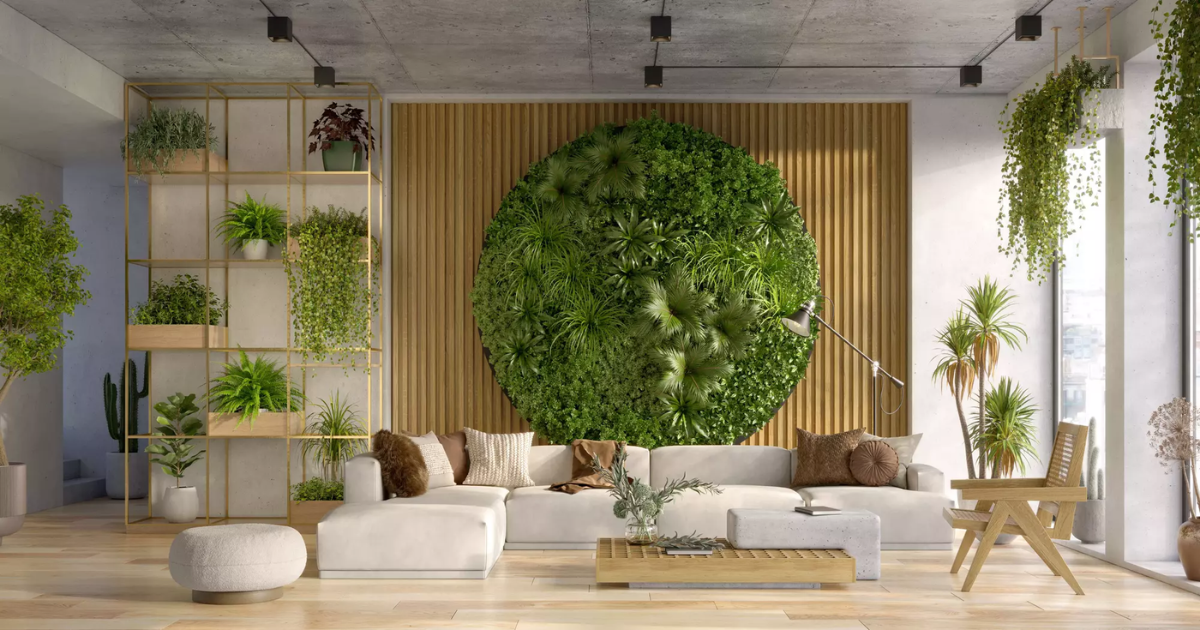In recent years, the importance of a healthy and harmonious living environment has gained widespread attention, and as people seek more balance in their lives, the integration of natural elements into interior design has become a rising trend. This design philosophy, known as biophilic design, centers on the idea of reconnecting humans with nature through interior spaces. An expert interior designer can use biophilic principles to not only beautify a home but also improve well-being, reduce stress, and enhance overall quality of life.
In this blog, we’ll explore the concept of biophilic design, its benefits for physical and mental health, key elements of this design approach, and how an interior designer can help you bring nature indoors for healthier living.
What is Biophilic Design?
The term “biophilic” comes from “biophilia,” a concept introduced by biologist E.O. Wilson in the 1980s. It refers to humans’ innate connection with nature. Biophilic design leverages this connection by incorporating natural elements into built environments to create spaces that feel more organic, calming, and engaging. An interior designer practicing biophilic design doesn’t just decorate with plants they aim to weave elements like natural light, organic textures, water, and greenery into the very fabric of the design.
Biophilic design can be implemented in both residential and commercial settings, from cozy homes to modern office spaces. In addition to creating a beautiful aesthetic, it also supports healthier living by promoting mental clarity, improving mood, and enhancing productivity.
Benefits of Biophilic Design for Health and Well-Being
Biophilic design is not just about aesthetics it’s deeply connected to wellness. Numerous studies have shown that being in natural environments or even viewing natural scenes can have significant benefits on physical and mental health. Here’s how this design philosophy can impact your life:
- Reduces Stress and Anxiety: Exposure to natural elements like greenery, water, and sunlight has been shown to lower cortisol levels and reduce stress. A home filled with these elements creates a peaceful retreat, which is especially important in today’s fast-paced world.
- Improves Air Quality: Plants in biophilic design do more than just beautify a space; they also improve indoor air quality by absorbing toxins and releasing oxygen. This can reduce respiratory issues and contribute to overall better health.
- Boosts Productivity and Focus: Biophilic elements can positively affect cognitive function. In environments designed with nature in mind, people tend to be more focused, productive, and creative. This is why offices and workspaces that incorporate biophilic principles often see improved employee performance.
- Enhances Mood and Well-Being: Natural light, greenery, and organic materials can have a profound effect on mood, reducing feelings of depression and anxiety. The calming influence of nature promotes a sense of relaxation and well-being.
- Increases Connection to Nature: In a world where many of us spend the majority of our time indoors, biophilic design helps reestablish our connection to the natural world, enhancing a sense of purpose and belonging.
Key Elements of Biophilic Design
An experienced interior designer uses several key elements when integrating biophilic design into a space. These elements help bring the outdoors in, creating an environment that feels natural and nurturing.
1. Natural Light
One of the most vital components of biophilic design is natural light. Maximizing exposure to sunlight has numerous health benefits, including regulating sleep patterns, improving mood, and boosting vitamin D levels. Large windows, skylights, and glass doors are ideal for allowing natural light to flood into a space. For areas where natural light is limited, an interior designer may use light-colored paint, mirrors, or reflective surfaces to enhance brightness and create a more open, airy feel.
2. Indoor Plants and Greenery
Indoor plants are perhaps the most common and effective way to introduce biophilic design into a space. Plants not only purify the air but also add vibrancy and a sense of life to a room. Whether it’s a small succulent on your desk or a large potted tree in your living room, greenery brings an organic touch that promotes relaxation. Vertical gardens and hanging plants can also be used to maximize greenery in small spaces.
3. Organic Materials and Textures
Materials like wood, stone, bamboo, and natural fabrics such as linen and cotton bring the raw beauty of nature into interiors. An interior designer might use wooden furniture, stone countertops, or natural fiber rugs to evoke a sense of earthiness. Textures play a significant role in biophilic design, as tactile surfaces like rough stone or smooth wood mimic the diversity found in natural landscapes, adding depth and richness to a space.
4. Water Elements
Water is a fundamental part of nature, and incorporating it into interior design can have a soothing, restorative effect. Whether through indoor water features like fountains or aquariums, the sound of flowing water promotes relaxation and enhances the overall atmosphere of tranquility. Even a simple tabletop fountain can add a calming touch to your living space.
5. Nature-Inspired Colors
An interior designer specializing in biophilic design will often use a color palette inspired by nature. Earthy tones like greens, browns, soft blues, and neutral hues evoke the natural world and contribute to a calming environment. These colors can be applied through wall paint, furniture, textiles, and decor. When combined with natural materials and lighting, they create a space that feels grounded and serene.
6. Outdoor Views and Connections
Incorporating views of the outdoors is another powerful way to engage with biophilic design. Large windows that overlook gardens, landscapes, or even urban greenery help bridge the gap between indoor and outdoor spaces. Sliding doors or patio access can further enhance this connection by allowing fresh air and natural sounds to flow inside. An experienced interior designer will design layouts that take full advantage of these outdoor views, ensuring that nature is always within sight.
7. Biomorphic Shapes and Patterns
Incorporating organic shapes and patterns into furniture, architecture, and decor mimics the forms found in nature. Curved lines, flowing forms, and irregular patterns, as opposed to rigid geometric designs, evoke a sense of movement and life. An interior designer might use biomorphic design in furniture, wall art, or lighting fixtures to create a more dynamic and natural-feeling space.
Practical Tips for Introducing Biophilic Design into Your Home
Whether you’re starting from scratch or looking to refresh your existing space, there are several practical ways to integrate biophilic design. Here are some tips to help you get started:
- Add Greenery: Place potted plants, vertical gardens, or hanging plants in various rooms to increase the presence of nature.
- Maximize Natural Light: Use sheer curtains or blinds that allow sunlight to filter through, and place mirrors strategically to reflect light.
- Choose Organic Materials: Incorporate wood, stone, and other natural materials into your furniture and decor for an earthy feel.
- Use Nature-Inspired Art: Hang artwork that depicts natural scenes or uses organic shapes and forms to enhance the biophilic vibe.
- Create a Focal Point: Consider adding a water feature, such as a fountain or an aquarium, to your home for a calming visual and auditory element.
- Bring the Outdoors In: If possible, open up your space to an outdoor garden or terrace to blur the lines between indoor and outdoor living.
Working with an Interior Designer for Biophilic Design
While there are many ways to introduce biophilic elements into your home, working with an experienced best interior designers in Chennai can ensure a cohesive, balanced, and effective design. A professional can assess your space, understand your needs, and create a customized plan that incorporates the principles of biophilic design seamlessly. Whether you want to introduce subtle touches of nature or completely transform your living environment, an interior designer can bring your vision to life while maximizing the health benefits of biophilic design.
Conclusion
Biophilic design offers a unique way to bring the healing power of nature into your home, promoting not only a more beautiful space but also a healthier, more balanced life. By working with natural light, greenery, organic materials, and nature-inspired shapes, an interior designer can help you create a home that feels alive, peaceful, and connected to the world around you. Whether you’re looking to reduce stress, improve air quality, or simply enhance the aesthetics of your space, embracing biophilic design is a step toward a healthier way of living.




